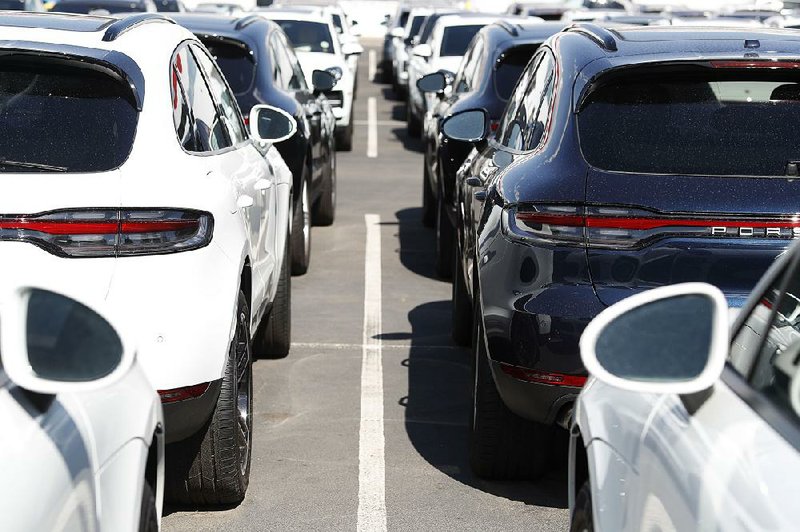WASHINGTON -- Consumer spending rose a healthy 0.3% in June, slightly below the strong gains of the past three months, while incomes turned in a solid 0.4% gain for the fourth-straight month.
The Commerce Department said Tuesday that the spending increase followed strong gains of 1% in March, 0.6% in April and 0.5% in May as the consumer rebounded after a lackluster start to the year.
An inflation gauge favored by the Federal Reserve showed prices rising 1.4% over the past year, well below the Fed's 2% inflation target. Fed officials are widely expected to reduce their benchmark interest rate today for the first time in a decade, in part because of the continued shortfall in inflation despite strong economic growth and unemployment at near a 50-year low.
The overall economy slowed to a growth rate of 2.1% in the April-June quarter from 3.1% in the first quarter as the trade deficit, which is a drag on growth, widened and businesses cut back on capital investment. The slowdown would have been much more severe if consumers had not rebounded after a sharp slowdown in the first quarter.
Consumer spending grew at an annual rate of 4.3% in the second quarter after a 1.1% gain in the first quarter. Economists are optimistic that consumer spending, which accounts for 70% of economic activity, will keep showing solid gains in the second half of this year.
The saving rate rose to 8.1% of after-tax incomes in June, reflecting annual revisions by the government, which sharply boosted the previous figures.
The slower spending gain reflected a modest 0.4% rise in spending on durable goods such as autos after a 1.5% gain in May.
The core personal consumption expenditures price gauge, which excludes food and energy, climbed 0.2% from the previous month and 1.6% from a year earlier, according to a Commerce Department report Tuesday that reflected annual revisions to more than four years of data.
While the Fed officially targets 2% annual increases for the overall consumer spending inflation index, it usually cites the core measure as a more useful indicator of underlying pressures because food and energy costs tend to be volatile.
Fed Chairman Jerome Powell has said low inflation may prove more persistent, while Chicago Fed President Charles Evans has said the risk that underlying inflation may be stuck below target and other weak price measures raise strategic concerns for the central bank.
Other reports Tuesday indicated the economy may be gathering momentum, potentially limiting the case for additional interest-rate cuts. Pending home sales rose in June by more than forecast, while consumer confidence increased to an eight-month high.
More Americans signed contracts to purchase homes in June, marking the second-straight month of growth.
The National Association of Realtors said Tuesday that its pending home sales index rose 2.8% to 108.3 in June, up from 105.4 in May. Pending home sales are up 1.6% from their pace a year ago, snapping a 17-month streak of annual declines.
Sales have likely been helped by lower interest rates, which are on average under 4% on a 30-year mortgage.
All four regions saw contracts rise from May and last year, with the West seeing the biggest jump in June at 5.4%. The West is also up the most year-over-year with gains of 2.5%.
Pending sales is a measure of home purchases that are usually completed a month or two later.
The report stands in contrast to recent data out over the past month pointing to weakness in the sector. Existing-home sales fell more than expected in June, while new-home sales missed estimates. At the same time, housing starts dropped to the slowest pace in three months as a decrease in apartment building outweighed a pickup in single-family projects.
"Job growth is doing well, the stock market is near an all-time high and home values are consistently increasing," Realtors association Chief Economist Lawrence Yun said in a statement. "When you combine that with the incredibly low mortgage rates, it is not surprising to now see two straight months of increases."
American consumer confidence rebounded this month to the highest level since November after drooping in June.
The Conference Board, a business research group, said Tuesday that its consumer confidence index rose to 135.7 in July from 124.3 in June. The bounce-back from last month's drop was much stronger than economists expected.
The index measures consumers' assessment of current economic conditions and their expectations for the next six months. Both rose substantially in July.
Information for this article was contributed by Martin Crutsinger and Paul Wiseman of The Associated Press; and by Jeff Kearns and Reade Pickert of Bloomberg News.
Business on 07/31/2019

